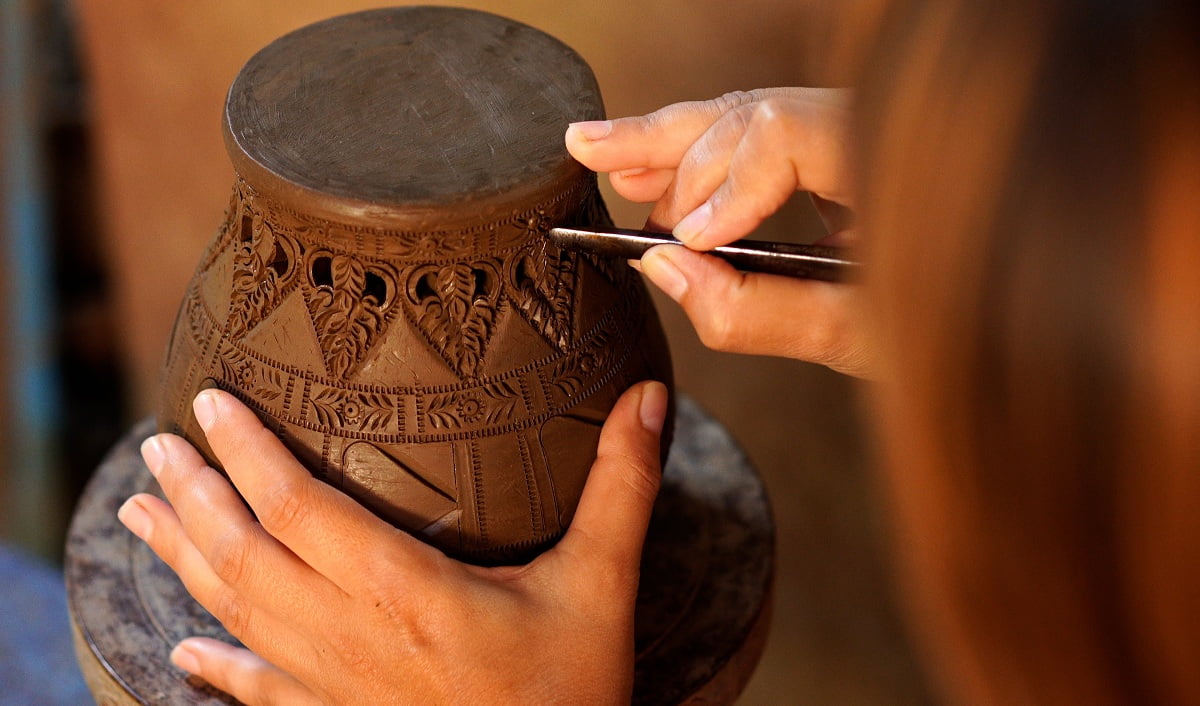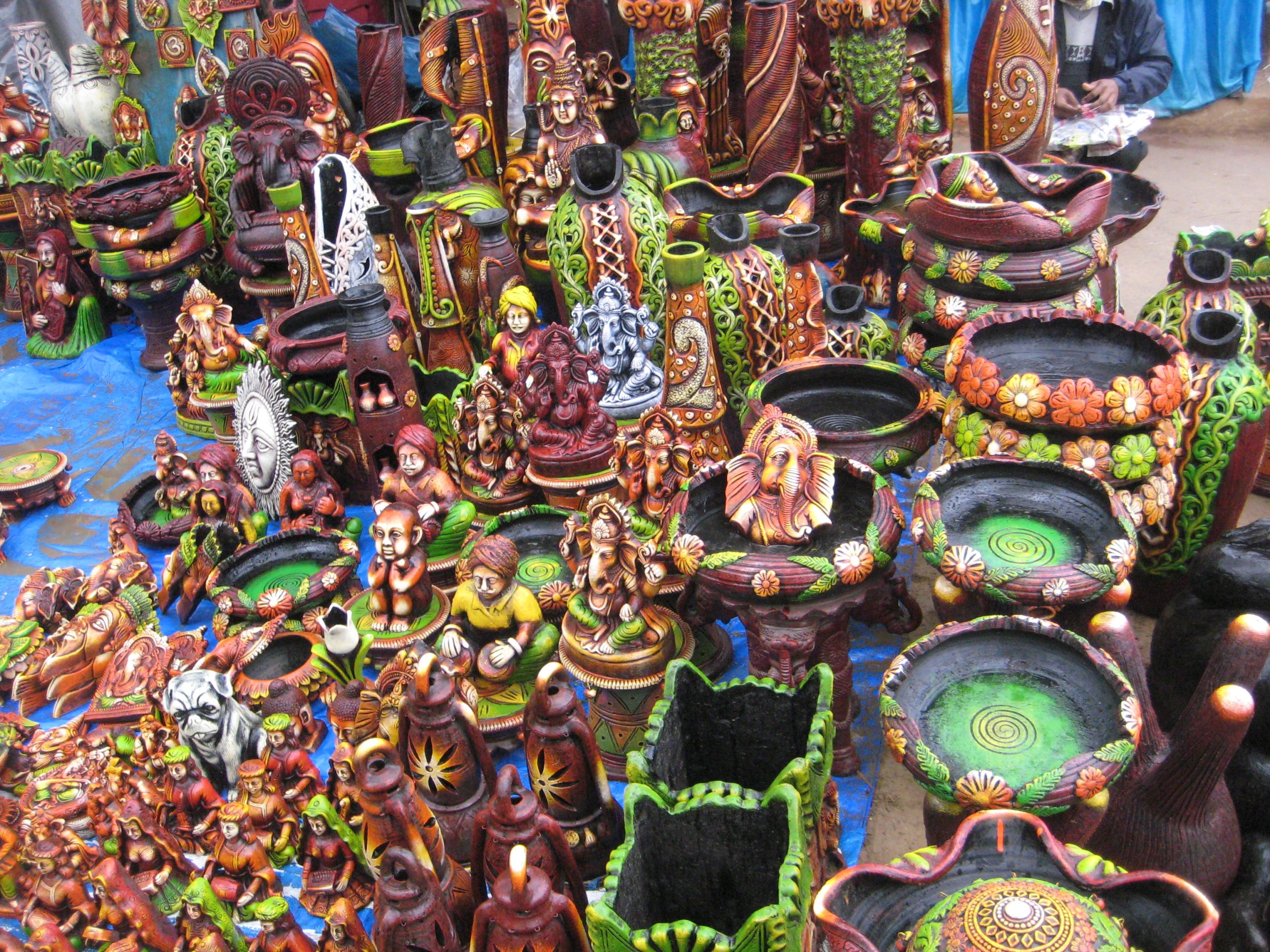What is the first thing that clicks in your mind whenever you see furniture made up of bamboo or a pashmina shawl? The former reminds you of Assam and the latter reminds you of Kashmir Valley. Do you wonder why it’s like that? The reason is “Handicraft,” which represents the culture of a region. Handicrafts are unique in their ways and nobody can copy them easily. Not just globally but handicraft business is quite profitable in India too. More than 212,000 artisans are producing 35,000 varieties of products. In this article, you will get thorough information about “The Outlook of the Handicraft Business in India.” Here it goes-
What are Handicrafts?

As the term suggests, “Handicrafts” are products that are made by hand using hand tools. These are handmade products prepared by using simple tools without any machines. They require a high level of concentration with effective hand-eye coordination and intense labor. However, the end product can either be functional or ornamental. People who are engaged in making handicrafts are called “Artisans.” Handicrafts represent the artistic culture and tradition of a region because they exhibit unique and distinct qualities.
Now coming to handicraft business, it is a very profitable business for a country, especially India. How? You may ask! Because they need low capital investments as compared to a corporate company. Also, they offer ample employment opportunities to artisans. They easily create brand value for themselves due to their uniqueness and authenticity. Owning handicraft materials also creates a sense of pride among many people worldwide. They act as a prominent medium for foreign exchange revenue. Therefore, they play a crucial role in the overall growth of our economy. Business analysts expect that the demand for handicraft products in India is going to rise exponentially. Thus, it is a positive indication of the growth of the Indian Economy.
Types of Handicrafts Business in India

There are five basic categories of handicrafts business in India, namely-
- Textile Handicraft– It refers to the artistic representation of designs on fabric material. It includes knitting, quilting, weaving, tailoring, pleating, and dyeing. The famous products of the Indian Textile Handicraft Industry are Pashmina Shawl, Banarasi silk sarees, Kalamkari from Machilipatnam, Rajasthani Dabus, and Pashmina shawls of Kashmir, etc.
- Decorative Handicraft– It involves the goods related to decorative arts like ceramic dolls & toys, glassware, basketry, jewelry, metal wares, sculptures, etc.
- Paper Handicraft– Papercraft has been prevalent in India since ancient times. It refers to the art of making three-dimensional stuff using paper. Papercraft artisans employ simple techniques like cutting, gluing, stitching, molding, and layering. You must have seen a popular paper handicraft called Sanjhi in Mathura and Vrindavan.
- Functional Handicraft– These are handicraft articles that serve a wide variety of purposes. For example, clay pots as serving materials, wooden or bamboo furniture, metal seals, and idols made up of clay, etc. For example- Kawuruda and Dhialu potteries of Himachal Pradesh, Bamboo crafts of Assam, Attars, etc.
- Fashion Handicraft– It includes purses, bags, apparel, etc. For example- Gota Zari Lace Potli bag, Jodhpuri suits, etc.
Market Overview of Handicraft Business
India has seen a rise in handicraft sales in the past year. Not only domestic sales but the number of exports also increased significantly bringing cheers to the Indian artisans. Apart from government efforts and initiatives, the e-marketing strategies immensely helped the artisans to sell their handicrafts through different portals. Despite facing tough competition from China, people prefer Indian handicraft products due to their superior quality. There is more demand for Indian products like earthenware, diyas, and other decorative items.
As of now, you must have realized that the Handicraft industry is crucial for the growth of the Indian economy contributing to the country’s export and employment generation. According to IBEF (Indian Brand Equity Foundation), the handicraft sector of India involves more than 67,000 export houses. It provides employment opportunities to more than 63.81 lakh artisans, belonging to the weaker sections of society. It significantly promotes craftsmanship and handicraft articles in domestic as well as international markets. This serves as the spinal cord of the rural economy of India. It provides a considerable amount of foreign exchange by simultaneously conserving the cultural legacy of our country.
The technological advancements aided in the improvement of Indian handicraft businesses’ marketing. Especially, social media platforms assisted in the global marketing of our indigenous handicrafts.
Key Market Segmentation of Handicraft Business
The major end-use sectors of the handicraft markets are either residential or commercial. Based on distribution channels, the Indian handicraft industry can be segmented into-
- Mass Retailers– They sell large quantities of goods to a broad range of customers. Some of the top handicraft companies in India are Asha Handicraft Association, Craft Maestros, etc.
- Departmental Stores– These are handicraft shops oriented towards personalized handicraft items.
- Independent Retailers– They sell handicraft products on an individual basis.
- Specialty Stores– They sell specialized kinds of handicrafts like pottery or bamboo furniture.
- Online Stores– They sell handicraft products on online platforms. Notable examples are- Indian Art Villa, Skywalk, VarEesha, etc.
Export Destinations of Handicraft Business

Indian handicraft products are getting highly popular in international markets due to their distinct features and aesthetic appeal. According to EPCH the major destinations of Indian handicrafts in the year 2021-22 were-
- USA– 38.38%
- UK– 6.40%
- Australia– 2.71%
- France– 3.85%
- Germany– 5.93%
- Netherlands– 5.58%
- UAE– 6.11%
- Others– 31.04%
As you can see the USA holds the highest position in terms of exports of handicrafts. It is a significant buyer of handcrafted textiles, zari woods, embroidered goods, jewelry, and shawls. Followed by Australia and UK for importing handmade carpets, wooden wares, and imitation jewelry. UAE and Germany are significant importers of Indian metal wares, art metals, and handprint textiles.
Export Trend
India is one of the leading handicraft-exporting nations both in terms of volume as well as value. During the year 2022, India exported handicrafts worth USD 4.35 billion. In the last couple of years, the demand for handicrafts goods, especially handmade carpets, has increased steadily. Thus, India accounted for 40% of global exporters of handmade carpets worth USD 716.21 million. Our country exported other major goods too like woolen shawls, wood wares, embroidered textiles, metal art wares, attars, imitation jewelry, and the list goes on.
Competitive Landscape
Some of the key competitors of the Indian Handicraft business in the International market are-
- Shandong Laizhou Arts and Crafts Imp. & Exp. Co. Ltd (China)
- Ngoc Dong Ha Nam Co. Ltd (Vietnam)
- Fujian Minhou Minxing Weaving Co. Ltd. (China)
- Vi.Le.Vi. (Italy)
- Yasar Acar Copper & Brass Handicrafts (Turkey)
Government Initiatives

Our government timely realized that there is a huge demand for Indian Handicrafts in domestic as well as Indian Markets. Hence, it will grow rapidly in the future and will highly contribute to the economic development of the nation. So, the government launched the following initiatives to promote the Indian handicraft industry-
- National Handicraft Development Programme (NHDP) – The objective of this initiative was to introduce new designs in handicraft products. Mainly to increase the knowledge of new design trends and colors of the artisans of the handicraft sector. The government accomplished it by carrying out surveys, upgrading the technology, providing insurance and credits, research & development, improving marketing activities, etc.
- Comprehensive Handicrafts Cluster Development Scheme (CHCDS) – Its objective was to establish modern and advanced infrastructure to provide adequate training to the artisans to produce diversification of traditional handicraft products.
Some other initiatives that our government launched are-
- Design and Technical Upgradation Scheme
- Export Promotion Scheme
- Credit Guarantee Scheme
- Baba Saheb Ambedkar Hastshilp Yojna
- Marketing & Support Services Scheme
- Bima Yojana for Handicraft Artisans
- Gandhi Shilp Bazaar Scheme
Conclusion
Indian Handicraft Businesses play a vital role in economic development as well as to combat recession. This industry represents the rich heritage, traditional skills, and talent of Indian cottage-based industries. Handicraft businesses have enormous potential in domestic as well as international markets. Even though the Covid pandemic led to a fragile situation for the artisans. But thankfully, the government took impactful initiatives and laid beneficial policies to put the handicraft industry back on track. Also, it wouldn’t be incorrect to state that e-marketing strategies and advancements in technologies played a crucial role in popularizing the handicrafts of India. Thus, the handicraft business of India is a major contributor to exports and the generation of revenue.

